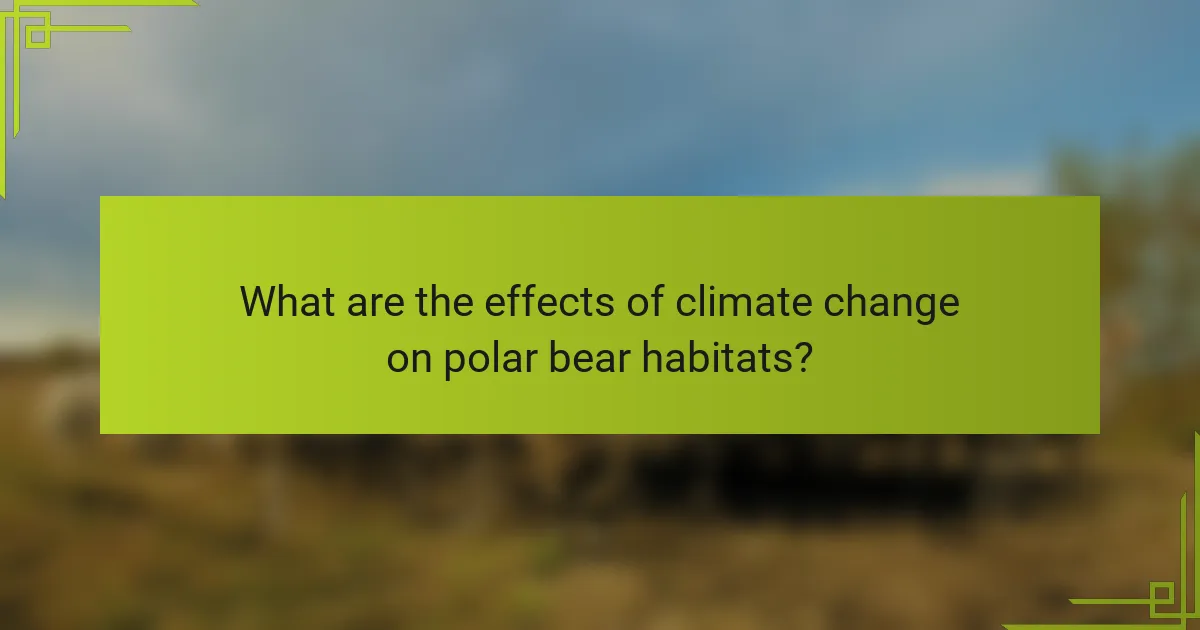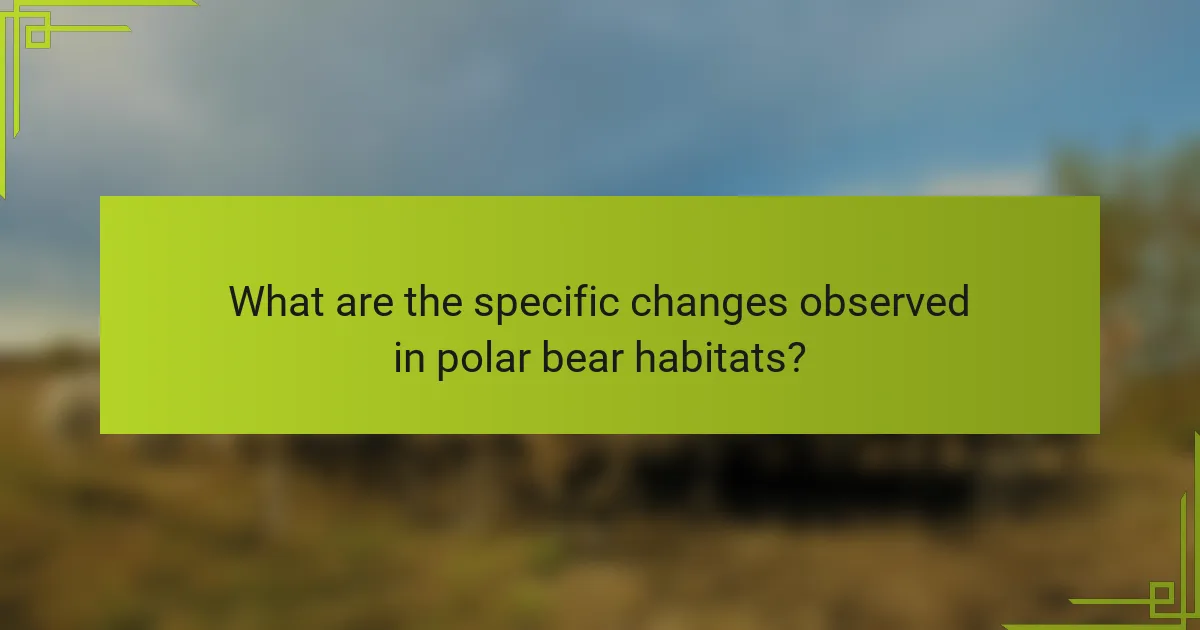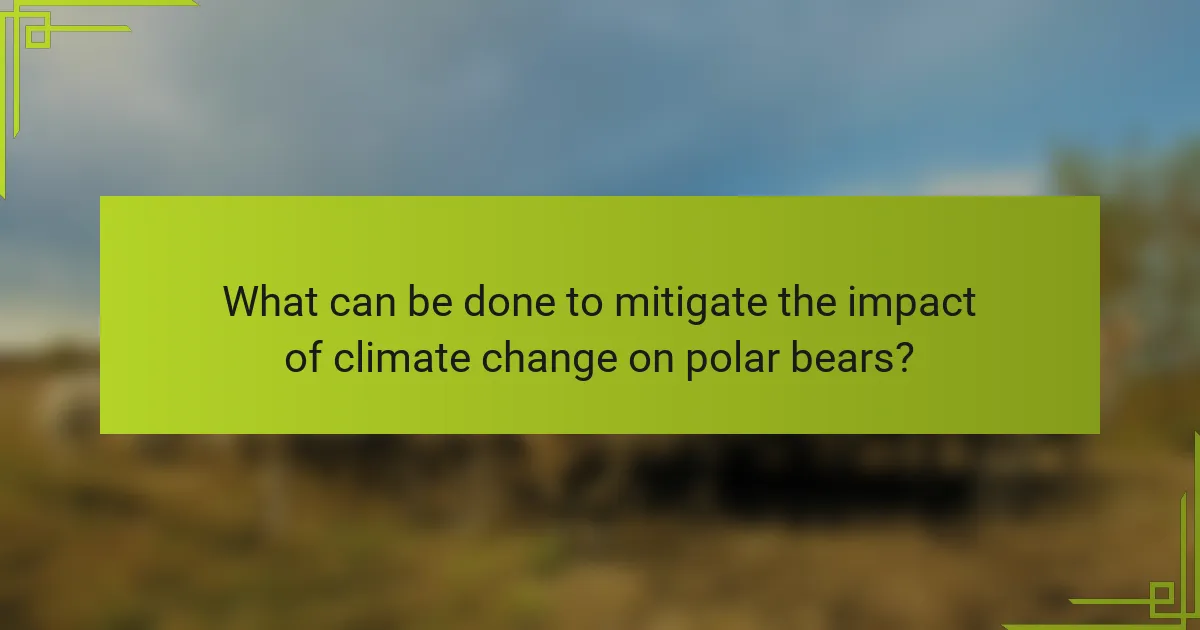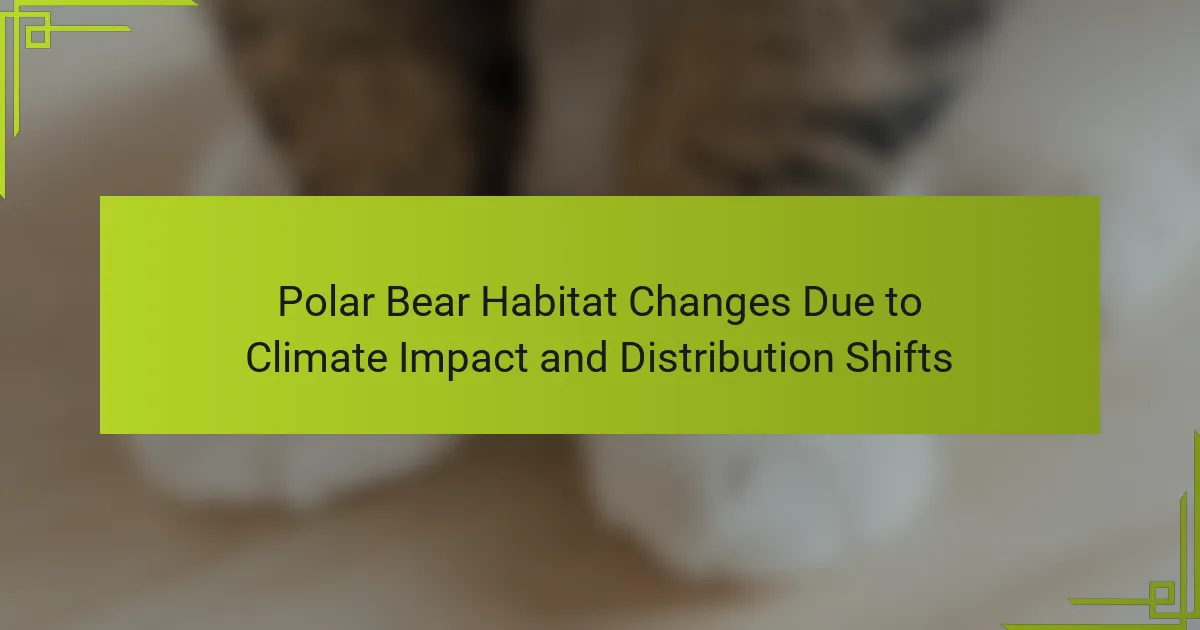Polar bears are facing critical habitat changes primarily due to climate change, which leads to the melting of sea ice essential for their hunting and breeding. The Arctic is warming at more than twice the global average rate, resulting in a 40% decline in sea ice since the late 1970s. This loss of habitat not only restricts polar bears’ access to their primary food source, seals, but also forces them to travel longer distances, increasing competition for dwindling resources. The article examines the impact of these environmental changes on polar bear populations, emphasizing the urgent need for conservation strategies and greenhouse gas emission reductions to ensure their survival in a rapidly changing climate.

What are the effects of climate change on polar bear habitats?
Climate change significantly affects polar bear habitats. Rising temperatures lead to melting sea ice, which is critical for polar bear hunting and breeding. The Arctic is warming at more than twice the global average rate, resulting in a decline of sea ice extent. Studies show that the Arctic sea ice has decreased by about 40% since the late 1970s. This loss of habitat reduces polar bear access to seals, their primary food source. Additionally, habitat fragmentation forces polar bears to travel longer distances for food. Increased competition for limited resources also stresses polar bear populations. Ultimately, these changes threaten the survival of polar bears in their natural environment.
How does climate change specifically impact sea ice availability?
Climate change significantly reduces sea ice availability. Rising global temperatures lead to increased melting of polar ice. According to the National Snow and Ice Data Center, Arctic sea ice extent has declined by about 13 percent per decade since 1980. This reduction affects polar ecosystems, including habitats for species like polar bears. As sea ice diminishes, polar bears face challenges in hunting seals, their primary food source. Additionally, the loss of sea ice disrupts the breeding and nursing of seals. The Intergovernmental Panel on Climate Change reports that continued warming will further exacerbate these effects. This creates a cycle of habitat loss that threatens the survival of polar bears and other Arctic wildlife.
What is the relationship between sea ice and polar bear hunting habits?
Sea ice is crucial for polar bear hunting habits. Polar bears rely on sea ice as a platform for hunting seals, their primary food source. As sea ice diminishes due to climate change, polar bears face challenges in accessing their prey. Research indicates that reduced sea ice leads to longer fasting periods for polar bears. They may travel greater distances to find food, impacting their energy reserves. In some areas, polar bears are observed spending more time on land, which is not conducive to hunting. This shift in behavior can affect their overall health and reproductive success. Studies show that declining sea ice correlates with decreased polar bear populations in certain regions. Thus, the relationship between sea ice and polar bear hunting habits is critical for their survival.
How does reduced sea ice affect polar bear reproduction?
Reduced sea ice negatively impacts polar bear reproduction. Polar bears rely on sea ice as a platform for hunting seals, their primary food source. With less sea ice, polar bears face food scarcity. This scarcity can lead to lower body condition and reduced fat reserves. Female polar bears need adequate fat reserves to support pregnancy and lactation. Insufficient nutrition may result in fewer cubs being born. Additionally, cub survival rates decline without sufficient maternal care. Research indicates that declining sea ice is correlated with lower reproductive success in polar bears. Studies show that in areas with significant ice loss, polar bear populations are declining.
Why are polar bear habitats shifting geographically?
Polar bear habitats are shifting geographically primarily due to climate change. Rising global temperatures are causing sea ice to melt at an accelerated rate. This loss of sea ice reduces the bears’ hunting grounds and access to prey. As a result, polar bears are forced to move to new areas in search of food. Research indicates that Arctic sea ice extent has declined by approximately 13 percent per decade since the late 1970s. This significant reduction in ice impacts the bears’ ability to find seals, their primary food source. Consequently, polar bears are increasingly observed in areas further north or closer to land. These shifts can lead to increased human-bear interactions as bears venture into populated areas.
What factors contribute to the migration of polar bears to new areas?
Climate change is a primary factor contributing to the migration of polar bears to new areas. Rising temperatures lead to the melting of sea ice, which is crucial for their hunting and breeding. As ice diminishes, polar bears are forced to travel greater distances in search of food. This migration often takes them to areas with more stable ice conditions. Additionally, changes in prey availability also drive their movement. Decreased seal populations can lead polar bears to seek new hunting grounds. Human activities, such as oil exploration, can further disrupt their natural habitats. Consequently, polar bears are increasingly observed in regions where they were previously uncommon. This shift poses challenges for their survival and adaptation.
How does the availability of food sources influence polar bear distribution?
The availability of food sources significantly influences polar bear distribution. Polar bears primarily rely on seals as their main food source. The presence of sea ice is crucial for hunting these seals. As climate change reduces sea ice, polar bears face challenges in accessing their food. This leads to shifts in their distribution towards areas with more stable ice conditions. Research indicates that polar bears are moving further north as a result of declining ice habitats. Studies show that polar bears have been observed traveling greater distances to find food. These changes in distribution can impact their breeding and survival rates. The decline in food availability directly correlates with increased stress and lower reproduction in polar bear populations.

What are the specific changes observed in polar bear habitats?
Polar bear habitats are experiencing significant changes due to climate change. The most notable change is the loss of sea ice, which serves as a crucial platform for hunting seals. According to the National Snow and Ice Data Center, Arctic sea ice extent has declined by about 13 percent per decade since the late 1970s. This reduction affects polar bears’ ability to find food and reproduce. Additionally, habitat fragmentation is increasing, isolating bear populations and limiting their movement. Warmer temperatures are also leading to earlier ice melt in spring, shortening the hunting season. These habitat changes threaten polar bear survival and overall population health.
How have temperature changes altered polar bear living conditions?
Temperature changes have significantly altered polar bear living conditions. Rising temperatures have led to the melting of sea ice, which is crucial for polar bears’ hunting and breeding. According to the National Snow and Ice Data Center, Arctic sea ice extent has declined by about 13 percent per decade since the late 1970s. This loss of habitat forces polar bears to swim longer distances to find food. Additionally, reduced ice cover limits their access to seals, their primary prey. Consequently, polar bears are experiencing increased stress and lower reproductive rates. These changes threaten their survival and contribute to population decline.
What are the physiological effects of rising temperatures on polar bears?
Rising temperatures negatively affect polar bears’ physiology. Increased temperatures lead to a reduction in sea ice, which is crucial for their hunting and resting. Polar bears rely on sea ice to access seals, their primary food source. As ice diminishes, bears experience increased energy expenditure while searching for food. This can result in weight loss and decreased reproductive success. Additionally, higher temperatures can cause heat stress, impacting their overall health. Research indicates that polar bears are experiencing thinner body conditions and lower cub survival rates as a consequence of climate change.
How do temperature changes affect the ecosystem surrounding polar bears?
Temperature changes significantly impact the ecosystem surrounding polar bears. As temperatures rise, ice habitats diminish. Polar bears rely on sea ice for hunting seals, their primary food source. Reduced ice coverage limits their hunting grounds. This leads to decreased access to food and increased malnutrition among polar bears. Warmer temperatures also affect the distribution of prey species. Changes in prey availability can disrupt the entire food web. Additionally, temperature fluctuations can alter the timing of seasonal events, such as breeding and migration. These factors collectively threaten the survival of polar bears and their ecosystem.
What are the long-term implications of habitat changes for polar bears?
Habitat changes have severe long-term implications for polar bears. As sea ice diminishes, polar bears lose critical hunting grounds. This leads to decreased access to their primary prey, seals. Consequently, polar bear populations face increased starvation risks. Additionally, habitat fragmentation can disrupt breeding patterns. Polar bears may also experience increased competition for food. Changes in habitat can lead to greater human-wildlife conflicts. The overall decline in polar bear populations is a significant concern. Studies indicate that without substantial climate action, polar bear habitats will continue to shrink, exacerbating these issues.
How might habitat changes influence polar bear populations in the future?
Habitat changes will significantly influence polar bear populations in the future. As climate change accelerates, sea ice is diminishing at alarming rates. Polar bears rely on sea ice for hunting seals, their primary food source. The loss of sea ice limits their ability to find food, leading to malnutrition and decreased reproduction rates. Studies indicate that polar bear populations in certain regions have already experienced declines due to these changes. For instance, the Southern Beaufort Sea population has decreased by nearly 50% over the last few decades. Additionally, habitat fragmentation can increase human-polar bear interactions, leading to further risks. These factors combined suggest that habitat changes will pose serious challenges to polar bear survival in the coming years.
What conservation efforts are in place to protect polar bear habitats?
Conservation efforts to protect polar bear habitats include the establishment of protected areas, international agreements, and research initiatives. Protected areas, such as national parks and wildlife reserves, help safeguard critical habitats from development and industrial activities. The Marine Mammal Protection Act and the Endangered Species Act in the United States provide legal frameworks to protect polar bears and their habitats. International agreements, like the Polar Bear Conservation Strategy, involve collaboration among Arctic nations to manage and conserve polar bear populations. Research initiatives focus on monitoring polar bear populations and habitat conditions, providing data to inform conservation strategies. These combined efforts aim to mitigate the impacts of climate change and habitat loss on polar bears.

What can be done to mitigate the impact of climate change on polar bears?
To mitigate the impact of climate change on polar bears, reducing greenhouse gas emissions is essential. Transitioning to renewable energy sources can significantly lower carbon footprints. Protecting and restoring Arctic habitats helps maintain the ecosystems polar bears rely on. Implementing conservation strategies can enhance the resilience of polar bear populations. Supporting sustainable practices in fisheries and tourism reduces human impact on their environment. Engaging local communities in conservation efforts fosters stewardship of polar bear habitats. Research and monitoring of polar bear populations ensure informed decision-making. These actions collectively contribute to the survival of polar bears in a changing climate.
What strategies are effective in preserving polar bear habitats?
Effective strategies for preserving polar bear habitats include reducing greenhouse gas emissions and protecting sea ice. These measures directly address climate change, which is the primary threat to polar bears. Implementing international agreements, like the Paris Agreement, helps limit global warming. Establishing marine protected areas can safeguard critical feeding and breeding grounds. Promoting sustainable practices in industries such as oil and gas is also essential. Engaging local communities in conservation efforts fosters stewardship and awareness. Research and monitoring of polar bear populations inform adaptive management strategies. These approaches collectively enhance the resilience of polar bear habitats against ongoing climate impacts.
How can communities contribute to polar bear conservation?
Communities can contribute to polar bear conservation by engaging in local stewardship programs. These programs often focus on habitat preservation and sustainable practices. Community members can participate in educational initiatives to raise awareness about polar bears and their ecosystems. They can also support local policies that protect polar bear habitats from development and pollution. Involving indigenous knowledge can enhance conservation strategies, as local communities often have valuable insights into polar bear behavior and habitat needs. Furthermore, communities can engage in research collaborations to monitor polar bear populations and health. According to the World Wildlife Fund, community-led initiatives have been effective in reducing human-wildlife conflict, which benefits both polar bears and local livelihoods.
What role does policy play in protecting polar bear environments?
Policy plays a crucial role in protecting polar bear environments by establishing regulations and guidelines for habitat conservation. These policies aim to mitigate the impacts of climate change on polar bear habitats. For example, the Marine Mammal Protection Act in the U.S. prohibits the harassment and hunting of polar bears, allowing populations to recover. Additionally, international agreements like the Polar Bear Conservation Plan promote cooperative management across countries. Specific policies also address greenhouse gas emissions, which directly affect sea ice loss, a critical habitat for polar bears. Studies indicate that effective policy implementation can significantly reduce habitat degradation and enhance conservation efforts.
What are the best practices for raising awareness about polar bear habitat changes?
Engaging the public through educational campaigns is a best practice for raising awareness about polar bear habitat changes. These campaigns should highlight the impact of climate change on polar bear habitats. Using social media platforms can effectively reach a wider audience. Interactive content, such as videos and infographics, can enhance understanding. Collaborating with environmental organizations can amplify the message. Organizing community events fosters direct engagement with local populations. Providing actionable steps for individuals to contribute can motivate involvement. Research from the World Wildlife Fund indicates that public awareness can lead to increased support for conservation efforts.
How can education programs help in promoting polar bear conservation?
Education programs can significantly promote polar bear conservation by raising awareness and fostering community engagement. These programs educate the public about the threats polar bears face due to climate change and habitat loss. Increased knowledge leads to greater public support for conservation efforts. Research indicates that informed communities are more likely to participate in conservation initiatives. For example, programs that involve local communities in polar bear monitoring have shown success in promoting stewardship. Additionally, education programs can influence policy by informing decision-makers about the importance of preserving polar bear habitats. Engaging youth through interactive learning experiences can inspire future conservationists. Overall, education is a critical tool in building a sustainable future for polar bears.
What actions can individuals take to support polar bear habitat preservation?
Individuals can support polar bear habitat preservation by reducing their carbon footprint. This can be achieved through energy conservation at home. Using energy-efficient appliances lowers electricity consumption. Additionally, individuals can opt for public transportation or carpooling to reduce vehicle emissions. Supporting renewable energy sources, such as solar or wind power, also helps.
Participating in local conservation efforts is another action. Many organizations focus on polar bear habitat protection. Donations to these organizations fund research and conservation initiatives. Advocating for policies that address climate change can influence government action.
Educating others about polar bear conservation raises awareness. Sharing information on social media can reach a broader audience. Simple lifestyle changes, like reducing plastic use, can also benefit polar bear habitats. Each action contributes to the overall effort to preserve their environment.
The primary entity of this article is polar bear habitats, which are significantly impacted by climate change. The article outlines how rising temperatures lead to melting sea ice, crucial for polar bear hunting and breeding, resulting in habitat loss and reduced access to food sources. It discusses the geographical shifts in polar bear habitats, the physiological effects of temperature changes, and the implications for polar bear populations, including decreased reproductive success and increased competition for resources. Additionally, the article highlights conservation efforts and actions individuals can take to mitigate these impacts and preserve polar bear habitats.
